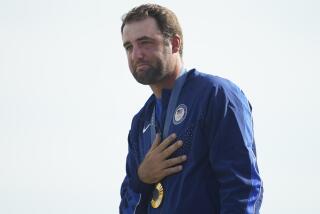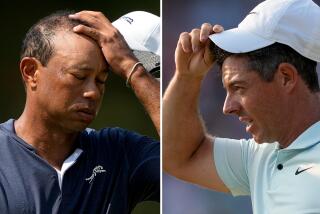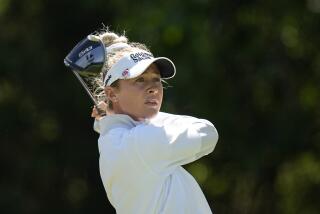Knowledge of caddies has turned golf into a team game
Reporting from carnoustie, scotland — They are the luggers of the clubs and the lifters of the spirit. They’re focused on what’s happening on the ground and in the skies, where winds constantly shift and foreboding clouds threaten rain at any moment.
They are the anonymous caddies, a one-person support system for the world’s best golfers, and rarely are they more essential than they are this week at Carnoustie, site of the British Open, with its howling gusts and fairways as firm as airport tarmacs.
“Every decision I make is bounced off my caddie,” said Brooks Koepka, a favorite in this championship and winner of the last two U.S. Open tournaments. “Everything we do on the golf course, it’s a decision I might make, or sometimes he’s got to pull the reins back and be like, ‘Listen, you need to hit the center of the green. There’s no reason to go at this flag,’ and he’ll kind of exaggerate it a little bit, how bad it’s going to be if I go at the flag, stuff like that.”
With millions of dollars at stake, golfers don’t tee it up and take their chances. Days of preparation and game-planning lay the groundwork for that first swing, and every one that follows. Much of that is done by the caddies, who keep incredibly detailed course books, with notes scribbled in cryptic shorthand, showing just where to aim the ball when the wind is blowing this way or that, the ideal landing spots to set up the next shot, which bunkers are absolute death, where the pin will be on a given day, anything and everything to get an edge.
“That course book is our bible,” said Ron “Bambi” Levin, who has caddied for David Duval, and will do so this week, but was on the bag for Todd Hamilton when he won the British Open in 2004 at Royal Troon.
Different golfers have different demands of their caddies.
“Some guys think you’re the butler,” Levin said. “For some guys, you’re Bill Belichick.”
At 48, Levin has been in this business a long time. He got the nickname Bambi when he started, in his late teens, as a wide-eyed newbie. The moniker stuck. The caddying game was different then.
“There were 10 guys out here that made a living at it, and 50 guys running from the law,” he said. “Now, it’s big business. There are a lot of [caddies] making six figures, and some of them making seven figures. It’s very cutthroat.”
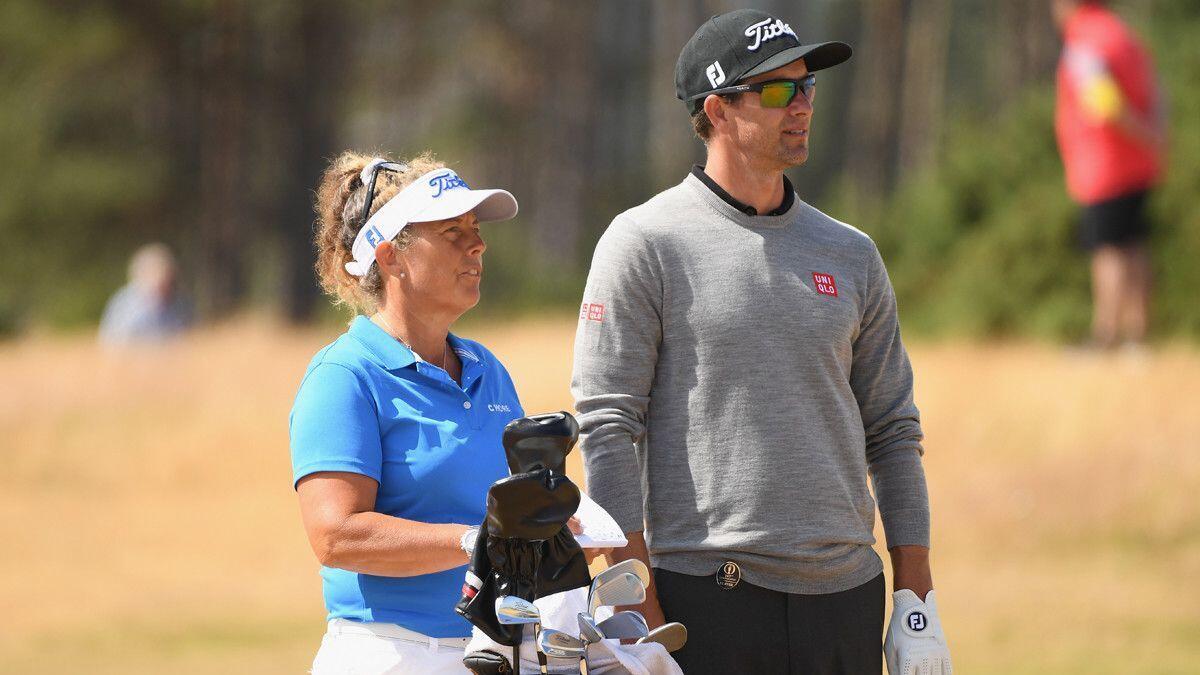
A big shift happened in the late 1990s, when Tiger Woods came on the scene, bringing massive crowds, enhanced TV interest, and a surge in prize money. That had a direct effect on the wallets of caddies, who typically earn between 5% and 10% of a players’ winnings, on top of a salary.
Suddenly, it wasn’t family members or college buddies of the golfers who were hoisting the bag around — although there are still some of those — but professionals who truly know the game, many of them expert golfers themselves.
More and more, golfers have started to use “we” rather than “I” when recounting their round to the media. It’s increasingly acknowledged that this is, in effect, a team sport.
“The joke between caddies when I first started was, ‘We make birdies and he makes bogeys,’ ” said Michael Collins, a former caddie for PGA Tour players Omar Uresti, Robert Gamez and others who now writes for ESPN.com.
“But now it’s like, we do everything as a team, and the players acknowledge it too. So many older players, they don’t like that. But they don’t have to like it, they’re not getting paid.”
Heading into Thursday’s start of the four-day championship, Woods and caddie Joe LaCava came up with strategies individually, then compared notes, as they would for any competition.
“Joey and I have worked great throughout the years,” Woods said Tuesday. “He walked it on Saturday, and it was quick. It was drier than it is now. And he basically formulated his game plan on his own, and then I’d come and play. I played on Monday. I had a pretty solid game plan to where I would play it too, how I think each hole should be played.
“Then as we’re playing a hole, we start talking about spots where we want to hit the golf ball. I would have to say every hole but one we’re on the same page, the idea of how to play each hole.”
Carnoustie does not look like a typical golf course. The khaki-colored fairways are faster than the meticulously maintained greens, where the grass is watered and verdant. So that, coupled with the winds, has some players hitting middle irons 300 yards or longer. On Sunday, Padraig Harrington knocked his drive on No. 18 into the burn, a stream that’s 457 yards from the tee. The ball hits the fairway here and runs and runs … and runs. A good caddie calculates that math problem and presents choices.
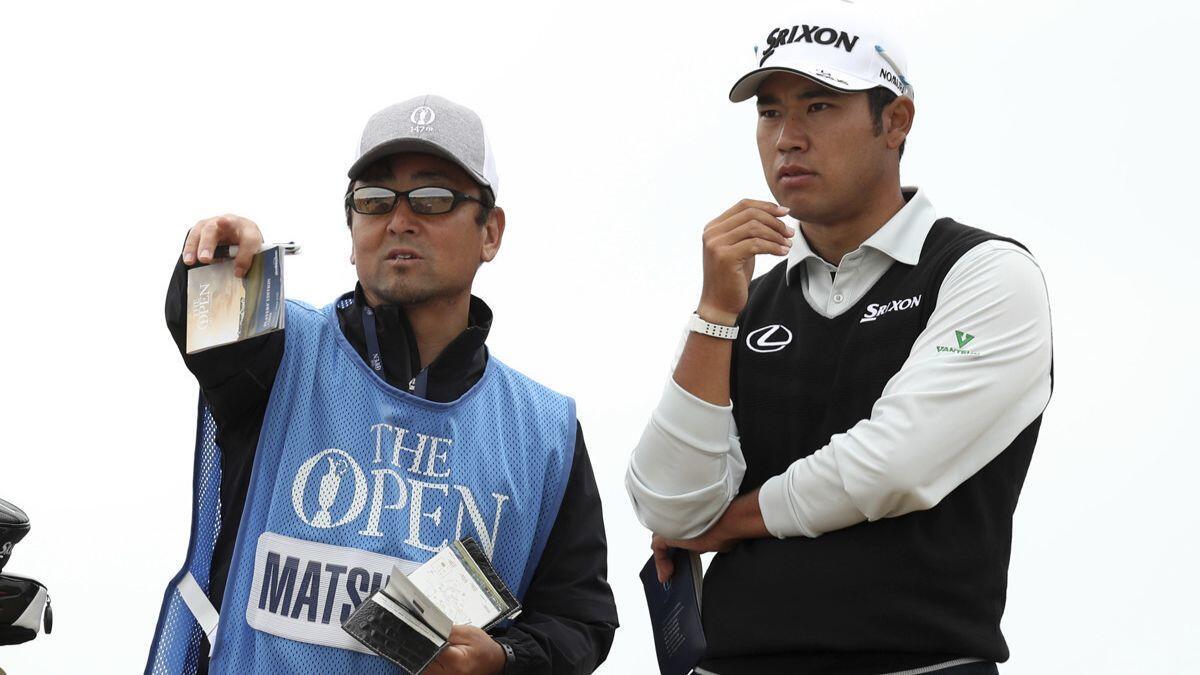
“You go to a lot of these courses these days and you might have one or two options,” said Jim “Bones” Mackay, who was Phil Mickelson’s caddie for 25 years and is now an on-course reporter for Golf Channel. “With what we’ve got going on here weather-wise and firmness-wise, you could hit four or five clubs off the tee. So the caddies are going to be really instrumental in what goes on this week.
“They’re all going to deserve a pint at the end of the week.”
There’s a lot more to being a caddie than shouldering a 40-pound bag, wiping clubs, raking sand traps, and holding an umbrella over somebody.
“Anybody can do 95% of what a caddie does,” Mackay said. “But the question is, are you capable of standing out in the 15th fairway with your player at Augusta National and talking him into a different club when he’s got all this adrenaline pumping through him and the tournament’s on the line? Not everybody can do that. I think that’s what separates the men from the boys out there, and it’s where caddies earn their keep. It comes down to club selection, and if you get that wrong enough, you’re not going to be in the business.”
Although PGA Tour caddies are almost exclusively men, Sweden’s Fanny Sunesson was a notable exception, helping Nick Faldo throughout the 1990s, when he won four of his six major championships. She later caddied for Sergio Garcia and Henrik Stenson, among others. She reportedly will caddie for Adam Scott this week. Brenda Calcavecchia will caddie for her husband, Mark, this week, as she has for several British Open tournaments.
For Levin, caddying brings to mind a different kind of female voice.
“I would say you’re Alexa out there,” he said, referring to Amazon’s virtual personal assistant. “ ‘How far is it to that bunker?’ ‘What’s the wind doing here?’ You can say what you want, but you can’t say, ‘I don’t know.’ ”
When it comes to putting, some golfers want to get input from their caddies, while others want to make those decisions entirely on their own. Then there are those competitors whose demands shift like the fickle gusts.
“When I caddied for Phil Mickelson, it was all about surfaces,” Mackay said. “I read a lot of putts in Florida on Bermuda greens, and I didn’t read nearly as many on Poa annua greens when we were in California. Some guys will read a ton, some guys won’t read hardly any at all.
“When Phil won his second major, he didn’t ask me to read a putt the entire week until the 72nd green when he had a two-footer to win the tournament. I think I just said something like, ‘If you hit it hard enough, it’s gotta be straight.’ ”
The putt went in, and Mackay’s breath went out.
“A big exhale, yeah,” the caddie said. “It was a moment we laughed about a lot after the fact.”
As a caddie, 90% of the job is saying something with absolute confidence — even if you’re not entirely sure you’re right.
For some, it’s fake it ’til you make it. That was the case with Collins, who was a stand-up comedian working in Hilton Head, S.C., during a golf tournament there. A group of caddies and golfers came to his show and invited him to the driving range. Collins then started booking shows wherever the tour was going to be.
He couldn’t break 120 on the course, and didn’t know what a handicap was. But he was a quick study.
“Omar Uresti is the first golfer I meet,” he said. “By Friday, I’m on the driving range. And his brother tells me, ‘I’m going to go eat. You take care of Omar.’ Because they had just finished their second round. So I put a towel on my shoulder, watching him hit.”
Collins watched the other caddies, too, and heard them compliment their golfers. He was mimicking that with Uresti, commenting on his shots, when an older golfer a few spots down called him over.
“The guy said, ‘Hey, kid, come over here.’ So I went over,” Collins said. “He was hitting a five-iron. He took it to the top of his swing and said, ‘Does that look square?’ So I’m looking at the shape and said, ‘Yeah, it looks pretty square to me,’ and he hits it — hyyaaa! — and it’s just a frozen rope.
“I’m like, ‘See?’ and he says, ‘Thanks, kid. That felt pretty good.’ ”
Collins, who knew nothing about golf, sauntered back to Uresti, who hit a shot then walked back to him with a burning question:
“What did Tom Watson want?”
Follow Sam Farmer on Twitter @LATimesfarmer
More to Read
Go beyond the scoreboard
Get the latest on L.A.'s teams in the daily Sports Report newsletter.
You may occasionally receive promotional content from the Los Angeles Times.

